Women's velveteen sundresses have remained fashionable for over 30 years. For a stylish look, it is enough to choose the right style and type of material. In order for the sundress to perfectly emphasize all the features of the figure, you can sew it yourself, but for this it is important to know which models are popular now, how to choose a color and how to correctly construct a pattern.
How to choose quality velveteen for a sundress?
Previously, corduroy fabric was made only from cotton, without any additives. Nowadays, you can still find natural material on the shelves of sewing shops, but experienced seamstresses do not recommend using it for sewing clothes.
Pure cotton corduroy has a rough texture and will be uncomfortable to wear. The edges of the finished product will require high-quality processing, as the natural material frays a lot.
For sewing a sarafan, velveteen made of cotton and synthetics is suitable. Such fabric is softer, does not crumble and wrinkles less. It is important to know that the higher the percentage of synthetics in the material, the more it will electrify and attract small specks and dust.
Therefore, corduroy consisting only of synthetics is not suitable for sewing clothes. It is better to give preference to a material that contains 45-60% cotton and 55%-40% synthetics.
What to look for when buying corduroy fabric:
- In the store, velveteen should be stored in rolls. If the material has been folded in several layers for a long time, then the pile at the bends may fall out or change color.
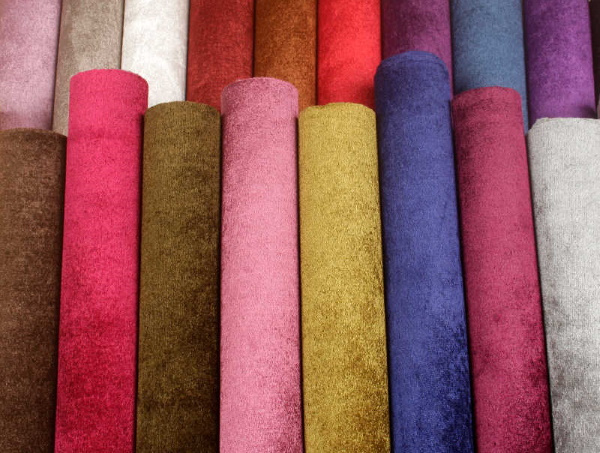
- Fabrics containing cotton and synthetics should not shine too much. If the fibers shine too much in the light, then this velveteen is made only of synthetics.
- The color of the material should be uniform, without dark or light spots.
Velvet fabric has a pattern of stripes. They are called ribs. All ribs should be even and parallel to each other.
What type of velveteen is suitable for a warm summer women's sundress?
Velvet is divided into subtypes by thickness, width of ribs and pile length. In the table below you can see a brief description of different fabrics. Knowing the characteristics of each type will help you choose the material for sewing a sundress for any season.
| Name | Characteristics | What time of year can you wear it? |
| Cord | Heavy and coarse fabric. Scar width from 5 mm. Contains cotton and wool. | Winter, autumn |
| Velveton | Thin fabric. Absorbs moisture well, lets air through and stretches. Has narrow ribs, about 2-3 mm wide. | Late spring, summer |
| Micro-velvet | Externally similar to velveteen, but less elastic. The fabric ribs are very narrow, barely noticeable (1-1.5 mm). | Summer, early autumn |
| Luxe Velvet | Thick and warm material. The pile length is higher than standard, the ribs are small. It holds its shape well, does not get dirty. | Winter, late autumn, early spring |
| Sky-velvet | Smooth texture without a pattern. Does not allow moisture to pass through, retains heat well. | Autumn, spring |
| Satin velveteen | Very short pile (0.2-0.5 mm), smooth surface. The fabric is thin and well ventilated. | Summer |
| Gloss | Elastic and thin material, without ribs. Allows air to pass through and absorbs moisture. Shines strongly in the sun. The composition contains a high content of synthetics, in some cases the fabric consists only of artificial threads. | Summer, late spring. |

Experienced seamstresses advise beginners to pay attention to the width of the ribs. Material with narrow stripes is always thinner and more elastic than corduroy with a large pattern.
Is it possible to sew a sundress from old velveteen?
If stored correctly, velveteen can lie in the closet for more than 15 years and not lose its presentable appearance. Therefore, new and beautiful clothes can be sewn from old fabric. If it was decided to sew a sarafan from a thing that was actively worn before, then the material should be carefully examined. It should not have any abrasions or holes. The color should be uniform, without noticeable stains.
Over time, the light shades of the pile may change and turn slightly yellow. In this case, the velveteen should be soaked in a weak solution of ammonia (1 tbsp. per 6 liters of water). After 1 hour, rinse the fabric under running water and dry it unfolded. If the material is wrinkled, all the folds should be doused with hot steam from the inside.
Current colors
Women's velveteen sundresses came into fashion back in the 70s and remain stylish today. Only the styles and shades change. The table below describes the fabric colors that will be relevant this year.
| Color or shade | What time of year can you wear it? |
| Pink, peach, coral | The beginning of spring |
| Blue, mint, azure | End of spring |
| Raspberry, linden, pastel orange | Beginning of summer |
| Bright red, yellow, lavender | End of summer |
| Burgundy, purple, brown | Beginning of autumn |
| Blue, grey, copper | The end of autumn |
| Cobalt blue, hazel, gold | The beginning of winter |
| Dark grey, black, light brown | End of winter |
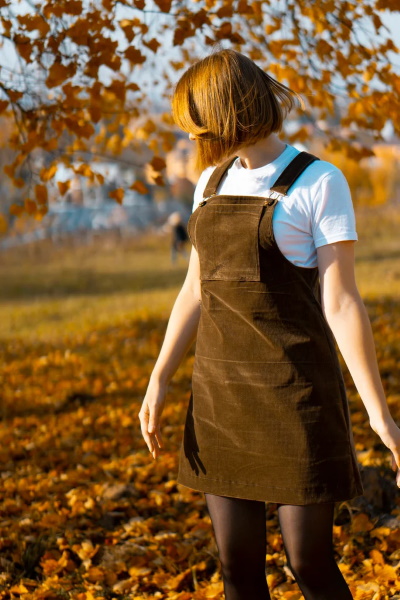
Materials with a high percentage of synthetics will shine more, this is important to consider when buying fabrics in metallic shades. Golden or silver velveteen gloss is suitable for concert and evening wear. A sundress made from such fabric for everyday wear will attract too much attention.
Fashionable styles
Sundresses made of velveteen suit all women, the main thing is to choose the right style for your figure. Slender girls should pay attention to fitted and tight models. You can choose any fabric for sewing. Thick and thin velveteen equally well emphasizes all the curves.
Women with curvy shapes and small figure flaws should give preference to items made of coarse material. It is not recommended to choose models with thin straps and a high waist. These styles will make your arms look thicker, and a high waist will “increase” your protruding belly. Straight-cut sundresses and a “shirt” style will hide flaws and help draw attention from your belly to your chest.
On young girls from 16 to 25 years old, models with an asymmetrical hem or wrap, as well as short sundresses with a fluffy skirt and lots of folds will look good.
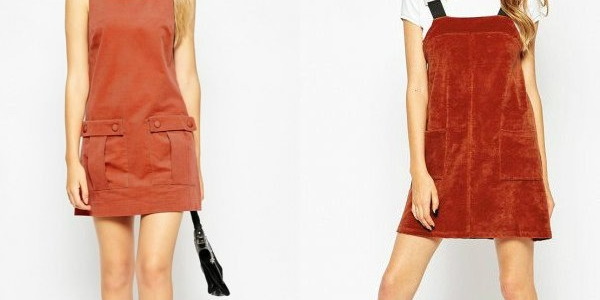
Women aged 50 and above should wear buttoned items with wide straps and no large pockets. The fabric should be thick and contain a small amount of synthetics. It is not recommended to wear too revealing models. Pregnant girls need sundresses that do not restrict movement. A-line and high-waisted models look good on a round belly and do not put pressure on it.
Taking measurements
A women's velveteen sundress requires care when constructing a pattern and taking measurements, especially if the chosen type of velveteen does not stretch.
First, you need to measure the chest circumference (CG). Place the tape measure under the shoulder blades and at the highest point in front. Measure the waist circumference (WC) by wrapping the tape around the stomach 2 cm above the navel. The next measurement is the hip circumference (HC). Place the tape where the buttocks protrude the most.
To correctly construct the pattern, you need to measure the length to the waist of the front and back. These are 2 different values and are measured separately. To find out the distance to the waist in front (Dtp), the end of the tape should be attached to the base of the neck, stretch the tape through the highest point of the chest and stop at the waist line. To make it more convenient, you need to tie a clothesline on your stomach. This line will indicate the waist.
The length of the product to the waist from the back (WB) should be measured by placing the tape from the base of the neck along the spine to the waist line.
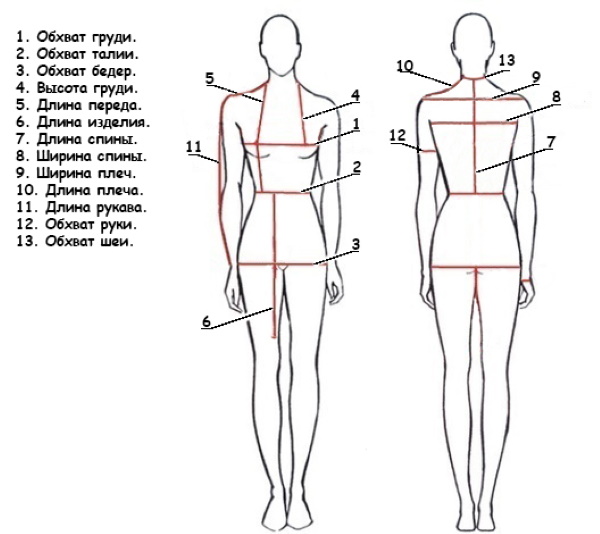
For a sarafan that will be tailored to your figure, it is important to measure the chest height (CH) correctly. The tape is laid from the base of the neck to the most protruding point. Inexperienced seamstresses often make the mistake of bending the tape towards the nipple. The line should be strictly vertical.
The last value to write down is the length of the product (LP). From the back, from the base of the neck, you need to pull the tape down the spine, to the legs, to the desired length. Do not press the tape to the back, the tension should be weak.
Making a pattern and sewing a velvet women's sarafan with your own hands. Step-by-step description
The patterns of all styles presented further in the article are based on basic drawings of different models of dresses. In accordance with the model, it is necessary to refine the pattern, in some cases it will be necessary to take several additional measurements.
Models with straps
A women's velveteen sarafan can have thin or wide straps. The straps can be made straight or crossed on the back. For such models, the basic pattern of a dress without a chest dart, only the front part of the drawing, should be taken as a basis.
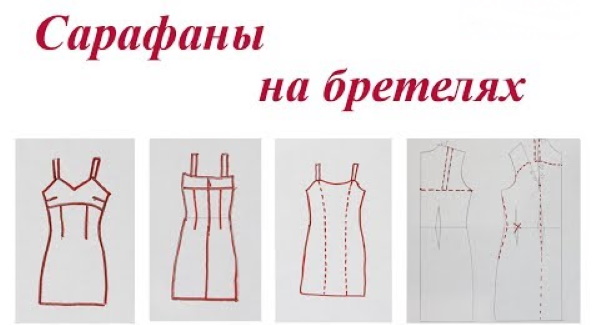
How to change the pattern:
- The armhole needs to be made 8 cm deeper.
- The neckline should also be enlarged. The back cutout should be 3-4 cm smaller than the front one.
- Mark the straps. They need to be shorter in the front and twice as long in the back.
- To prevent the bottom of the product from being too narrow, you need to make a cut on the side. From the bottom edge of the product, on the side, you need to blunt 12-15 cm up.
How to sew a sundress:
- The front and back pieces need to be sewn along the side seam up to the slits.
- Iron the seam allowances from the inside out and stitch.
- Fold and iron the seam allowances at the back and front of the neck, stitch.
- Process the edges of the straps and sew them to the sundress.
- Hem the hem.
Such simple models can be supplemented with 1 or 2 wide pockets. The size and depth are selected individually.
Button models
To sew a sarafan with buttons in the front, you need to take as a basis a basic pattern of a straight-cut dress or a classic fitted model. You won’t have to change the drawing too much. You only need to divide the front part of the pattern lengthwise into 2 equal halves and make allowances of 3-4 cm to fold the fabric at the edges. You can also adjust the armhole and remove the sleeves, add wide straps (5-6 cm).
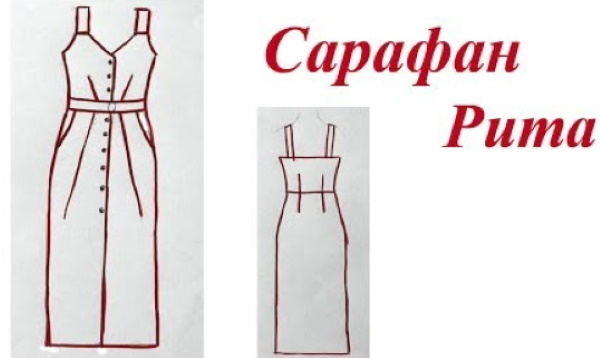
How to sew a sundress with buttons:
- Sew the back and both halves of the front along the side seams.
- On the left side, step back 3 cm from the cut and make cuts for the buttons. Process them on an overlock. Fold the cut, iron and stitch.
- On the right, fold 3 cm on the cut on the right side of the front. Sew on the buttons.
- Finish the bottom and neck of the dress, front and back.
- Sew on the straps.
If the pattern of a fitted dress was taken as a basis, then several slits for a belt can be made on the waist.
Summer options
A women's velveteen sundress, intended for summer, can be sewn using an A-shaped silhouette pattern, then no changes in the construction of the drawing are needed. If you plan to make a model with a belt and a high waist, then you need to take into account the number and width of the folds on the skirt. You can sew a summer sundress with an open back from thin velveteen. The pattern consists of 7 parts. The straps should be wide, trapezoidal in shape.

Creation:
- Measure the chest width from the side seam to the solar plexus. Draw a trapezoid, the bottom of which will correspond to this value, and the top should be 2-3 times narrower. The length of the strap of this style corresponds to the height of the chest + half-girth of the neck.
- Cut out 4 identical pieces and sew 2 together, turning them wrong side to each other.
- Cut out a belt the same length as the waistband, 12 cm wide. Fold in half and stitch along.
- For the skirt, you need to draw a rectangle with sides DI*(OB+10 cm). In the front, make 4 folds 2.5 cm wide.
- Assemble all the pieces. The seam on the skirt should be at the back, as well as on the waistband.
The straps can be tied at the neck, but it is better to buy special fasteners and sew them to the narrow edges of the straps.
Warm options
To sew a winter sarafan, you will need a thick fabric with a high pile. You can take the same patterns as for a model with buttons or straps. The most popular version of a warm product is a straight silhouette. To sew, you will need to take a pattern of a basic straight dress, mark the place for the darts on the chest, remove the sleeves and slightly increase the armholes.
How to assemble such a product:
- Fold and iron the seam allowances at the neck and armholes, stitch.
- Sew the halves of the product along the sides.
- Fold and stitch the bottom of the sundress.
For convenience, you can make 1 or 2 side cuts of 10-15 cm.
Floor length
It is better to sew a maxi-length sarafan from thin corduroy. You can take any basic dress pattern as a basis. You will only need to change the shape of the sleeves and the length of the product. In order for a long sarafan to be comfortable to wear, it is necessary to make side slits. If they are located on both sides, then their length should be up to the knee. If only one slit is planned, then it should be extended by another 7-12 cm upwards.
Wrap style
The top of such styles is modeled according to the basic pattern of the base dress. The front part of the pattern is changed, dividing it into 2 parts at an angle. It is necessary to add seam allowances of 3-4 cm. For the pattern of the skirt, a drawing of the lower part of a fitted dress is suitable.

How to assemble the product:
- At the bottom, make a gathering on the front parts of the top.
- Sew side seams and shoulders together.
- Treat the neck.
- Make a wrap at the front by placing the wide piece over the narrow one.
- Sew the bottom pieces along the sides.
- Finish the bottom of the hem.
- Sweep the top and bottom pieces and stitch.
- Process the armholes.
It is important not to forget to make folds along the waistline on the top of the sundress and on top of the skirt, otherwise the velveteen will stick out unattractively in these places.
How to decorate a women's sundress?
Corduroy sarafans are decorated with two wide pockets, placed on the sides or one in the middle. The straps can be made detachable by sewing on special hooks or inserting rivets. Fine embroidery or a small felt applique looks good on short pile.
It is not recommended to decorate a product with wide ribs with beads or sequins. Such decoration will visually make a stylish sarafan simple and "tasteless".
What to wear with it, how to combine it?
A velvet sundress does not go well with open shoes, so it is better to give preference to ankle boots, boots and closed shoes. In cool weather, you can wear nylon tights or plain leggings underneath.
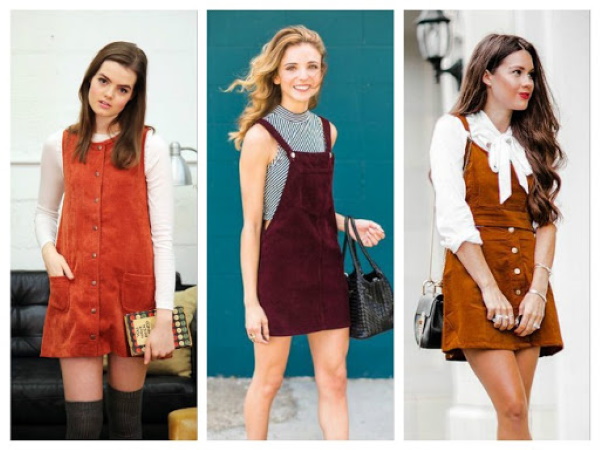
You can wear a turtleneck, a long-sleeved shirt or a contrasting pullover under a sundress with wide straps. For layering, designers recommend wearing a denim jacket as well. In summer, the style with straps is worn with a light T-shirt underneath and without tights.
Warm models with closed shoulders go well with a thin chiffon scarf on the neck. As a headdress, you can take a felt hat with wide, wavy brim. A women's sarafan made of velveteen is easy to sew yourself.
The main thing is to choose the type of fabric and style that matches your figure and age. Ready-made ones are easy to care for, and since velveteen will not go out of fashion for a long time, a sarafan can last more than 4 seasons.
Video about making a sarafan from velveteen
How to sew a velveteen sundress:
